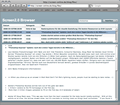Screen2.0
archive // 2006.12.29 08:00:13 [hh]
DxO-VP Luc Marin im Interview: "Software will re-define how cameras are designed and perform"
 Mit Luc Marin, Vice President of Photography Business bei dem französischen Profi-Photosoftwarehersteller DxO Labs, sprach Screen2.0 über die Hintergründe des jüngsten Programms "DxO Optics Pro 4.1". Lesen Sie hier das englischsprachige Interview exklusiv und in voller Länge.
Mit Luc Marin, Vice President of Photography Business bei dem französischen Profi-Photosoftwarehersteller DxO Labs, sprach Screen2.0 über die Hintergründe des jüngsten Programms "DxO Optics Pro 4.1". Lesen Sie hier das englischsprachige Interview exklusiv und in voller Länge.
Screen2.0: DxO Labs started 2002 as a spin-off of Vision IQ. What is your relation to this company today? Who are the main investors today?
Luc Marin: Vision IQ and DxO Labs are two independent, separate companies. Jérôme Ménière is the founder of both companies.
Apax Partners is the lead investor together with Société Générale Asset Management SPEF Venture, Thalès Ventures/ACE Management as well as Japanese funds CSK Venture Capital and Hitachi Venture.
Screen2.0: DxO Labs also provides embedded solutions for camera manufacturers. With which companies do you work together?
Marin: Image Science by DxO was embedded in the Carl Zeiss Camera-Eyepiced DC4 for Digiscopes transforming this spotting scope into a full-fledged digital imaging product.
Due to confidentiality agreements, we do not divulge the names of other camera or cameraphone manufacturers with whom we work on embedded solutions.
However, eight of the top 10 camera manufacturers use DxO Analyzer in the laboratories.
Screen2.0: What are the main competitors that you see for "DxO Optics Pro"? Do you see Apple's "Aperture" and Adobe's "Lightroom" as competitors?
Marin: DxO Optics Pro is complementary to these kinds of products, just as its complementary to Photoshop. In fact, we recently launched DxO Optics Pro as a Photoshop plug-in (starting with v4.0)
Screen2.0: What makes "DxO Optics Pro" really unique from your perspective and sets it apart from the competition?
Marin: Three things make DxO Optics Pro unique:
1. A very high degree of automation to our image corrections.
2. The core corrections are based on actual measurements of the camera and lens performance, not an approximation.
3. Very high skill in image processing science thanks to the level of the R&D Team.
Screen2.0: The automatic correction of "DxO Optics Pro" works pretty well for almost all situations except for low-key shots in dark light and very foggy shots? Is there a way to handle them separately in automatic correction mode?
Marin: Im not sure how automatic distortion correction for example produces different quality results in the fog or with a clear sky
However, when the user wants to adjust how DxOs automated corrections work there are two important options :
- our Expert Mode provides a huge amount of control to adjust what the software does.
- once a satisfying result has been achieved, the settings can be saved as a preset for later use on other images.
Screen2.0: How do the results from "DxO Analyzer" flow back into the "DxO Optics Pro" product? What are the main tasks when creating new camera and lens profiles?
Marin: DxO Analyzer and other tools are used to measure and model camera/lens performance. This information is then injected into the creation of a DxO Module.
For each camera and lens the characterization is done for all their settings such as focal length, aperture, shooting mode, white-balance mode and so forth; it involves many shots of specific targets for all camera/lens settings at precise exposure conditions performed within our testing lab. A lens/camera profile ends up is an enormous file in which all the characterization data organized in an easily readable format from which DxO Optics Pro to perform corrections.
Screen2.0: What are your decisions based on to decide which camera and lens profiles to support? Do you also do your own market research? What will be the next camera/lens kits that you will support?
Marin: We carry out our own market research plus receive requests from users and prospective users through the website.
The next camera we will support is the Nikon D40 with a variety of lenses including the kit lenses.
Screen2.0: What kind of corrections do you provide and which of those are camera and lens specific?
Marin: We have three types of corrections in DxO Optics Pro
1. Corrections that work on any image (any camera). For example the DxO Lighting correction.
2. Corrections that work if we support the camera body, even if we dont support the lens. For example RAW conversion & Noise reduction.
3. Corrections that only work if we support the camera and the lens. Optical corrections in particular.
Screen2.0: Do you consider a "do-it-yourself camera and lens profiling" feature for "DxO Optics Pro" like some companies provide for their software?
Marin: A do it yourself profiling technique to the level that we do it would require efforts outside the capabilities of almost any individual.
However a simpler model could be possible.
Screen2.0: Version 4.1 of "DxO Optics Pro" introduced a performance boost as well as the "Film Pack". What can we expect in the future from this interesting software?
Marin: The feedback has been huge on DxO FilmPack. We are very very happy with it. We are looking at expanding it in three possible different directions
- More film looks and possibly other types of looks
- More adjustments available for fine tweaking
- Make the DxO FilmPack available outside of DxO Optics Pro
No firm plans are being announced at this time.
Screen2.0: You announced quite recently a bundle with "iView". How much of cataloging, sorting and tagging workflows will you cover in future releases "DxO Optics Pro"?
Marin: We want to work as harmoniously as possible with companies like iView who specialize in this area. Our focus is image processing, image quality and image enhancement with a heavy emphasis on automation and reliability.
Screen2.0: What is your main focus in terms of overall product development for the future?
Marin: DxO Labs is working on three different but complementary and interacting business lines:
- Embedded imaging, see our product with Carl Zeiss for example. Also major work going on for cameraphones.
- Image Quality Measurement Tools (aka DxO Analyzer)
- Software for demanding photographers the DxO Optics Pro product line.
Screen2.0: Which major trends do you see in digital photography and image processing today?
Marin: Software will be the most differentiating factor. Software will re-define how cameras are designed and perform.
Werbung












